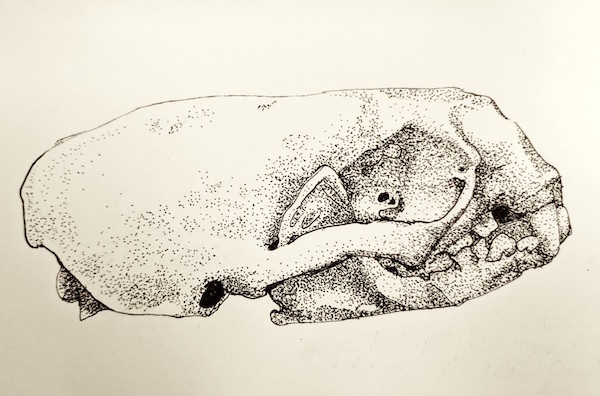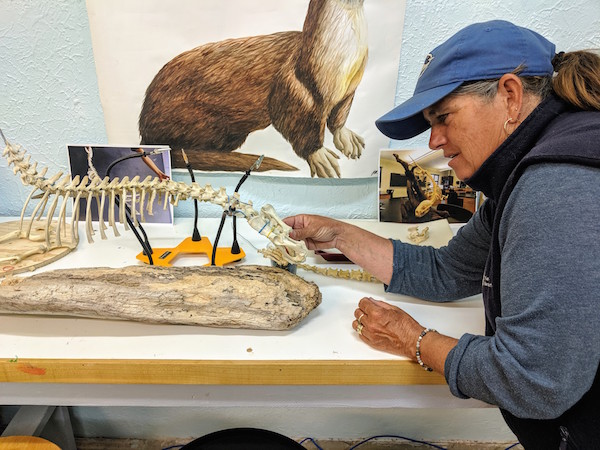
In 2015, Sarah Grimes picked up this river otter’s carcass on a rugged beach covered in tumbled sea glass. She removed its skin and flesh and soaked its bones first in warm water, then Borax. She kept each section of the skeleton — legs, paws, spine – in a separate mesh bag so the bones wouldn’t get mixed up. Then she cleaned the bones and put the skeleton back together, a process called rearticulation.
Grimes is the Marine Mammal Stranding Coordinator for the Noyo Center for Marine Science in Fort Bragg, California. She is trained and permitted to pick up dead sea mammals and judge how they died. This river otter looked thin, and probably starved to death – its displaced hip joint would have made it difficult to swim. “Poor little nugget,” she said, showing me where the otter’s leg once attached to the rest of the skeleton.

I met Grimes at a scientific illustration class in Fort Bragg yesterday evening. (Drawing dead animal bones in the fog is my ideal summer vacation.) Nearly everyone else who showed up was a Noyo Center volunteer, including the instructor, an artist named Jasmine O’Neill Martin. As the class drew the assembled specimens – a sea lion’s scapula, the river otter’s long-fingered paw – they chatted about the big rearticulation project they are working on, a 26 foot-long orca skeleton.
The orca washed ashore in 2015 after getting tangled in a crab pot line. It is the second whale skeleton that Fort Bragg residents have reassembled. The first, a 73 foot-long blue whale, died in 2009 after being hit by a ship’s propeller. After the city obtained rights to the blue whale’s carcass, volunteers hauled the whale’s 70 tons of bones up a 40-foot cliff and buried it in the forest. Four years later, they dug up the bones, soaked them in degreasing agent, and scrubbed them clean at a wastewater treatment plant.
Both whale skeletons are now in storage. They will be reassembled with the help of articulator Lee Post, also known as “The Boneman,” who has written a spectacular collection of instruction manuals for reassembling animal skeletons, ranging from porpoises to nutria to moose.
I stippled my otter skull, one dot at a time. Although it might feel aimless at first, Martin said, we could be sure that the end product would be realistic. Inking its contours reminded me of the map Grimes is creating in the Noyo Visitor Center, using colored pins to represent where the bodies of different species of marine mammals are found.
More than 167 grey whales have washed up dead along the west coast of North America this summer, and scientists think warmer seas are contributing to the die-off. Global warming is also responsible for the 60-fold spike in purple urchins decimating Northern California kelp forests, the staple underlying the entire food chain represented on Grimes’ map. It can be difficult to link each pin, or even a cluster of colored pins, to global warming, she says. But dot by dot, a picture emerges.
The volunteers working on the skeleton included a high school student, an in-home caregiver, a third-grade teacher. Later, I thought about how very human the town’s response has been to the whale deaths: collective grief, burials, excavations, a planned educational museum to display the skeletons.
I also thought about that word – rearticulation – and how it encompasses our urge to gather dead whale bones and put them back together. It so beautifully captures our need to describe the animals we threaten: to draw them, to study them, to write their Latin names on educational plaques. Also, our faith in language. As if by saying the right words, we could bring the whales to life again.
That’s fascinating work.
Question: Why was the blue whale buried, and then dug up after four years? Was the burial meant to be permanent? Or does temporary burial do something for this process? So curious.
Poor whales. They’re victims of our global warming, while we try to honor/understand them.
Michele, burying the whale allows insects/microorganisms to soften/remove much of the flesh, to make processing easier. I also know of a whale that was sunk in chains in a quiet section of ocean, so fish and other marine creatures could perform the de-fleshing. Removing whale flesh is a giant, potentially disgusting job…best to leave it to many small experts who benefit from the work…